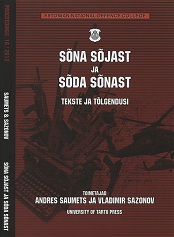Militaarne retoorika: Araabia kevade sündmuste kajastamine ajalehtedes Postimees ja Eesti Päevaleht
Military Rhetoric: Representing the Events of the Arab Spring in the Daily Newspapers Postimees and Eesti Päevaleht
Author(s): Karen KuldnokkSubject(s): Language and Literature Studies
Published by: Kaitseväe Ühendatud Õppeasutused
Summary/Abstract: This article analyses military rhetoric in the discourse of the Arab Spring, focusing on articles published in Postimees Online and Eesti Päevaleht Online (18 texts). The research method used in the article is critical text analysis. The article examines ways in which events in the Arab world were defined and described, and also the perception of different participants in the conflict (the Arab World, Western countries, etc.). The rhetoric of the Arab Spring discourse was compared to the rhetoric of the Iraqi discourse. The comparison is based on the author’s doctoral thesis „Military Rhetoric: The Influence of Language used by the Media in the Discourse on Estonian Defence Policy” defended in August 2011. The study revealed that during the initial stages of the events of the Arab Spring the rhetoric was hopeful. Words such as awakening, liberation, dawn were used in the discourse. Towards the end of 2011, the initial hope turned to disappointment. New metaphors were developed to express this, such as the Arab Autumn and Arab Winter. In both the Iraqi and Arab Spring discourses, Estonians were equated with the local population of the respective countries, and it was emphasised that the Estonian people could understand these peoples because they shared the experience of suppression. The Iraqi discource and the Arab Spring discourse differ in the following aspects: in the case of the Iraqi conflict, Western countries, Estonia, and the local dictatorial regime were the main concern and agents of the text (it was also our war); in general the Iraqi people were not shown as active participants in the events, rather, they were represented as passive or as sufferers. The Arab Spring events were, by contrast, viewed from a distance, the local people as well as the dictatorial regime were the main agents of the text, and to a lesser extent also Western countries and Estonia.
Journal: KVÜÕA toimetised
- Issue Year: 2012
- Issue No: 16
- Page Range: 40-56
- Page Count: 17
- Language: Estonian

